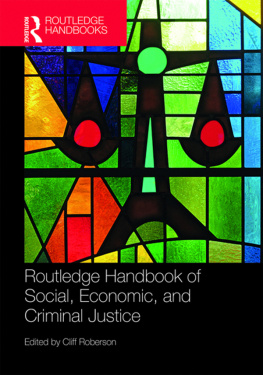Introduction to Criminal Justice Information Systems
Ralph Ioimo

CRC Press
Taylor & Francis Group
6000 Broken Sound Parkway NW, Suite 300
Boca Raton, FL 33487-2742
2015 by Taylor & Francis Group
CRC Press is an imprint of Taylor & Francis Group, an Informa business
No claim to original U.S. Government works
Version Date: 20160310
International Standard Book Number-13: 978-1-4987-8836-6 (EPUB)
This book contains information obtained from authentic and highly regarded sources. Reasonable efforts have been made to publish reliable data and information, but the author and publisher cannot assume responsibility for the validity of all materials or the consequences of their use. The authors and publishers have attempted to trace the copyright holders of all material reproduced in this publication and apologize to copyright holders if permission to publish in this form has not been obtained. If any copyright material has not been acknowledged please write and let us know so we may rectify in any future reprint.
Except as permitted under U.S. Copyright Law, no part of this book may be reprinted, reproduced, transmitted, or utilized in any form by any electronic, mechanical, or other means, now known or hereafter invented, including photocopying, microfilming, and recording, or in any information storage or retrieval system, without written permission from the publishers.
For permission to photocopy or use material electronically from this work, please access www.copyright.com or contact the Copyright Clearance Center, Inc. (CCC), 222 Rosewood Drive, Danvers, MA 01923, 978-750-8400. CCC is a not-for-profit organization that provides licenses and registration for a variety of users. For organizations that have been granted a photocopy license by the CCC, a separate system of payment has been arranged.
Trademark Notice: Product or corporate names may be trademarks or registered trademarks, and are used only for identification and explanation without intent to infringe.
Visit the Taylor & Francis Web site at http://www.taylorandfrancis.com
and the CRC Press Web site at www.crcpress.com
CRC Press is a premier publisher of scientific, technology and medical content, reaching around the globe to publish the pioneering achievements of science that provide researchers, professionals, and students with the resources they need to make further advances. CRC Press is a member of Taylor & Francis Group, an informa business.
For more authoritative books in your field and for in-depth information about CRC Press books, visit www.crcpress.com
- Join our email list to receive exclusive, unadvertised discounts and alerts when new books publish in your field
- Visit Featured Authors to learn about your favorite author with detailed bios, news about their work, and discussions of their research
- Read the latest book reviews from industry experts, influencers, and thought leaders about STM (Science, Technology and Medicine) reference and textbooks
The tables in this ebook have been modified to enhance the reader experience. On compatible devices, the enhancement should keep the header rows visible as you scroll through a table.
Please report any issues with this ebook or any desired enhancements to the .
www.crcpress.com
This book is dedicated to my father, who was a great source of encouragement throughout my life. He always knew that I could achieve things even when I didnt think I could. I am sure he is looking down at me today with a big smile and saying, See, I told you that you could do it. Thank you, Dad.
Preface
During my lifetime, there were two events that influenced my future in information technology. In 1966, while I was in high school, I took a personal typing course, not realizing how important knowing how to type would become in our information technology age. Then in 1972, as I was preparing to graduate from college and had put off taking a math course until my final quarter at California Polytechnic University, San Luis Obispo, California, I was granted permission to substitute that math course with a computer science programming course. These two events became critical to my future and my contribution to criminal justice information systems.
In 1976, I transferred from the patrol unit to the planning, training, and research unit in the police department I was working for at the time. The first task the chief of police assigned me was to prove with empirical data that our department was in need of additional police officers. That is when I designed a patrol workload study that measured not only the number of calls for services we handled on a given shift but also the time consumed in handling these calls for service and other officer-generated activity. Here is where I put to use that computer science course that I took in my last quarter in college. I went to the city engineer and told him what we needed to do, and together he and I wrote a program on a Hewlett Packard 9830 Programmable Calculator in a new language called BASIC. The program captured the data pertaining to each call, and from this information, we were able to confirm that the officers spent 94% of their time on calls for service and officer-generated activities and 5% on administrative activities, leaving no time for unobligated patrol.
The Law Enforcement Assistance Administration declared the Patrol Workload Study a National Exemplary Project. The importance of this study is that I was asked to chair the National Steering Committee for the nations first generic police record management system known as Police Operations Support System Elementary (POSSE). POSSE became the standard that is at the base of all record management systems to this day. Since these early days, I have had the pleasure of helping to implement information technologies in criminal justice agencies throughout the United States.
Criminal justice information systems have come a long way since the early days. Information technology permeates every aspect of the criminal justice environment as it does our everyday lives. The intent of this book is to provide an overview of the various software systems and technologies used in todays criminal justice environment and to suggest where this technology will evolve to in the future.
Acknowledgments
Professionally, I want to thank Paul Wormeli for his assistance in providing information used in this book. Paul is a pioneer in criminal justice information systems, and together we have implemented hundreds of criminal justice information systems across this nation. Together we have also conceived new technologies that public safety agencies use today but have no idea where the concepts that gave birth to these technologies came from. Paul has led the nation in promoting criminal justice information systems and continues to be a visionary in this field.
I also would like to thank the following firms for contributing the product examples used in this edition:
- CrimeStar Corporation: a software firm that provides computer-aided dispatch, police records management systems, field mobile computing systems, and jail management systems.
- Microfirm Software Corporation: a software firm that provided the various screen samples from their prosecutor information system.
- PTS Solutions: a software firm that provided the various screen samples from their court management system.
Personally, I also want to thank my family for their support and understanding throughout the many years while I traveled across the country implementing information technology systems for justice agencies and for their patience with me on vacations when I was working in support of these agencies.







